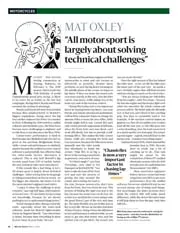
Mat Oxley
MotoGP pre-season testing commences at Sepang, Malaysia, on February 6. The 2019 season, which marks the 70th birthday of world championship grand prix racing, is likely to be every bit…
In some respects, Bentley represents the original British motor car of the interwar period. Yes, there may have been one or two marques (such as Vauxhall or Morgan) that pre-date its establishment but none has maintained its importance for so long, nor remained so central to an established narrative of British national pride. Walter Owen (WO) Bentley founded Bentley Motors Limited on January 18, 1919, the very same day that the Paris Peace Conference was begun to formalise the end of World War I. An engineer by trade, W.O. initially worked in the rail industry before gravitating towards the automobile industry, engaging in a joint venture selling French cars with his brother. Going on to modify their engines for better performance, their improvement yielded numerous records set at Brooklands before the war. His pre-war experiments with automobile engines translated into wartime service during WWI as he was given a prominent role in the Royal Naval Air Service, helping improve the performance of warplanes.
As soon as he was able, W.O. returned to cars, transforming his workshop in Cricklewood, London, into a centre of automobile development. Seeing competition as central to the success of his design as well as an effective means of advertising, he early on prioritised racing, sending cars to compete locally at Brooklands, in hillclimbs and even in the 1922 Indianapolis 500, the vehicle finishing last in 13th place.
While Bentley’s racing fortunes improved almost immediately following this event – the team would go on to win the 1922 Tourist Trophy and a private entry would finish fourth at the inaugural 1923 Le Mans 24 Hours – the company’s 1924 success at Le Mans signalled a new level of achievement. It also coincided with the first year of publication for Motor Sport magazine – at this time called the Brooklands Gazette – a coincidence resulting in a parallel development of magazine and car maker that would dovetail into the creation of a synchronous British pride. In the magazine’s very first road test, the 3-litre Speed Model Bentley was greatly praised by its reviewer, the article ending with a rather subdued yet still discernible articulation of a narrative of British supremacy that would become ever more explicit in the coming years:
Interest in the Bentley is naturally enhanced by this car’s splendid victory in the French Grand Prix d’Endurance last month. The Bentley was the only British car amongst some 40 competitors, and its outstanding performance throughout the race provides a notable tribute to British engineering in general, and to Bentley design and workmanship in particular.
The two following seasons were a mixed bag. Following a disappointing Le Mans in which neither Bentley finished, a record-breaking (and pride-salvaging) endurance run was held at France’s Montlhéry Circuit in September 1925, John Duff and Joseph Dudley (JD) Benjafield lapping in Duff’s modified Bentley for 24 hours at an average speed of 95mph. Le Mans in 1926 also proved a disappointment, with all three Bentley entries failing to finish. But as Motor Sport put it, this was not bad luck for Bentley but for Great Britain itself: “Great Britain, represented by three Bentleys, experienced very bad luck in not putting up a better show in this event.” It is clear that Bentley was already being viewed as a standard bearer for British achievement.
The 1926 setback set the stage for the most glorious period in Bentley’s history, a span of four consecutive years during which Bentley reigned at Le Mans. This string of results – achieved by a group of wealthy and courageous motorists such as Woolf ‘Babe’ Barnato, Dr J Dudley ‘Benjy’ Benjafield, Sir Henry ‘Tim’ Birkin, and SCH ‘Sammy’ Davis – known collectively as ‘the Bentley Boys’ – was not, however, only a victory for the marque but a triumph for Britain itself:
The Le Mans victory by a 3-litre Bentley is one of which all concerned may feel pretty proud. In England we are able to have no road races at all, and there is nowhere in the country where a race can be held for 24 hours. In spite of this, an English car can go abroad and beat allcomers in a race under conditions our more fortunate continental friends can be much more intimately acquainted with. The team of Bentleys, in spite of racing far from home and under conditions which can never be imitated in this country, proved themselves easily the best cars on the course.
While a great many articles were printed in Motor Sport about Bentley’s accomplishments at Le Mans between 1927 and 1930, the importance here lies not in illustrating the sheer volume of reflections, but in the continuity of the message from one article to another, the vast majority paying homage not only to Bentley’s remarkable success but to its ability to outlast rivals. Bentley’s feat – and the resonance of a message built upon a base of British adaptability and resourcefulness – was made all the more important given what Motor Sport called “British insignificance” in the world of grand prix racing. It becomes clear that in a relatively short period of time the Bentley achievement of the latter half of the 1920s had taken on a critical national meaning and become an example of British perseverance, even as it failed to achieve a similar success in other categories.
Bentley’s meaning lingered even after it was absorbed by Rolls-Royce in 1931 via an unseemly veiled purchase in the wake of the 1929 Stock Market Crash and the arrival of the Great Depression that crushed a Bentley company unable to navigate the restricted financial realities of the period. During the Second World War, Bentley reappeared again as a bearer of national pride in the pages of Motor Sport, even as William ‘Bill’ Boddy – installed as editor in 1936 – struggled to keep the magazine afloat during those perilous times. At the very beginning of 1944, a piece entitled “Great British Achievements” appeared, to remind its readers of their much-needed patriotism and of their role in echoing the heroic deeds of ‘the Bentley Boys’:
Great credit is due to the old Bentley Company, W.O., Woolf Barnato and the rest of the Bentley Boys. Bentleys, at Le Mans, have done more for Britain than almost any other team anywhere, and they have left a tradition and heritage of which we may feel justifiably proud.
In the post-war period, Bentley maintained its position as a critical articulation of national pride. As Britain increasingly lost the respect it had achieved by resisting Nazi aggression during the Second World War due to its increasingly strained relationships with elements of the British Empire, key commercial enterprises such as Bentley – with their golden age in a sufficiently distant past that could be filled with nostalgia – became some of the last bastions of national honour. At the same time that Britain would be swept up in a miscalculated attempt to maintain its national interests at Suez in a ham-fisted and duplicitous strategy with the French and Israelis, Boddy reviewed the latest Bentley S-series, ending the piece with a none-too-subtle reference to Britain’s waning strength and the Bentley’s importance in maintaining some semblance of British pride:
The British lion may spend much of its time lying down these days but is still capable of getting up and facing the world in a bold and dignified manner, and such productions as the Bentley S-series remind us that this is so. This is the company director’s motor car par excellence, and it is fitting that men who control British destiny should drive these fine cars from Crewe, rather than chromium-draped floating drawing-rooms of other than British origin.
For many years after, Bentley settled into quiet complacency, not only built on the same platform as contemporaneous Rolls Royces but also becoming a symbol of opulence and luxury much like its sister brand. Bentley’s sporting heritage was forgotten, the name having become aligned with plutocratic interests while the greater number of Britons faced oil crises and necessary restraint.
In the early 1980s we see an interesting evolution in the positioning of Bentley within Motor Sport. Setting the stage for a review of the latest car, Alan Henry noted how “no fewer than 30 years passed between the introduction of the R-Type Bentley Continental and the subject of this test, the Bentley Mulsanne turbo; more than a generation during which those offerings marketed behind the Bentley radiator were basically Rolls-Royce models bearing cosmetic alterations.” Then, after a recounting of how “the Rolls-Royce company devoted itself to obliterating Bentley’s own individual character,” the reviewer went on to describe how, “Now, thanks to the commercial awareness of Rolls-Royce Motors, Bentley individuality is on offer once again with the £61,744 Mulsanne turbo, the first forced-induction machine to carry the winged ‘B’ motif for half a century.” Yet the discussion of Bentley’s “individuality” – and the importance that lay in naming the car after the main straight at Le Mans – would for the moment still be overlooked by the decades-long connection to luxury that had been forged since Rolls Royce’s 1930s acquisition of the marque.
Fifteen years on, Andrew Frankel’s review of another new Bentley did not fail to recognise the significance of the Mulsanne’s name, nor the name of the newer Bentley Arnage:
This is the first of several slices of good news concerning this new Bentley. It was, I suppose, not a difficult name to have guessed, given the last new Bentley saloon was named Mulsanne. Working your way around the Le Mans circuit, it’s not difficult to see why “Ford Chicane” and “Porsche Curves” were ruled out while “Indianapolis” clearly struck the wrong chord. Which left just Tertre Rouge, the Esses and Arnage. The board has faced tougher choices than this in the recent past.
This new Bentley – the first to be launched after the legendary marque’s acquisition by the Volkswagen Group – represented a significant step in a longer strategy we can now identify: to rekindle the marque’s sporting character.
Motor Sport – the magazine that had helped create the brand’s racing pedigree in the first place – was more than happy to play a similar role in this newer more nostalgic age. Frankel drove two Bentleys side by side in that test at Le Mans, piloting a 1929 4½-litre around before hustling the newer Arnage on the same famous roads. His review would end with a strong statement that placed the car and the marque’s return in its longer historical sweep: “My judgment is that the future for Bentley is brighter now than at any time since before the war, which, given that it has just produced its best car since that time, is both fitting and just.”
One further point remained to be settled for the narrative of British triumphalism – albeit one now under German stewardship – to be complete: a return to racing and to Le Mans. Frankel had already hinted at the enthusiasm for such a step in his 1998 article, noting that “If you talk to the people from Bentley today they talk longingly about a return to motor racing and refuse to say never.” So it should not have come as a surprise to see a new Bentley assault Le Mans in the early 2000s amid expanding sales figures. Reflecting almost a decade later on Bentley’s win in 2003, Frankel notes how Bentley’s chairman Franz-Josef Paefgen brought him down to earth about his decision not to go back to Le Mans in 2004:
I remember pontificating about how no one remembers a single Le Mans win […] and how as W.O. proved in the ’20s, if you’re to derive real value from a campaign you need to win and win again, leaving an indelible mark on the event as Jaguar, Ford, Ferrari, Porsche and now Audi have done. His view, expressed with impressive candour, was that I was being naïve: the purpose of the project was to help transform the image of the company ahead of the late 2003 launch of the all-new Continental GT road car, the machine that would entirely transform Bentley’s business.
According to Paefgen, the mission had been completed, the marque revitalised by this important victory. But, according to Frankel, the victory had a deeper meaning, one that depended on peeling back the layers of the design of the car itself and laying to rest an idea that the victorious Bentley in 2003 was not a rebadged Audi as suggested in some quarters, but a real Bentley and that it was truly a British victory that had taken place:
Does it matter that, engine aside, it was also British from end to end? It probably shouldn’t, but it does. This was a Bentley after all, and though it was designed and built by others (just like Jaguar’s Group C cars) the programme was devised and developed by Bentley in Crewe. It brought inspiration to a workforce, and pride to a nation that had waited over a dozen years for a British car to win Le Mans again.
The narrative had been completed, and the interwar British achievement and national triumphalism had been canonised, largely due to its treatment in the pages of Motor Sport.



